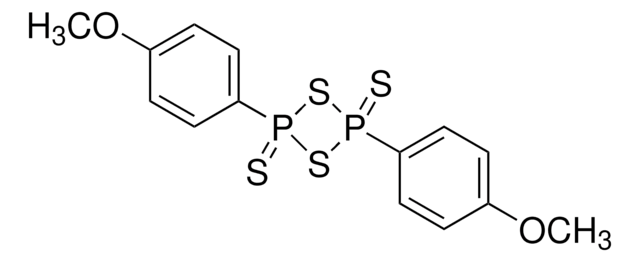All Photos(2)
About This Item
Linear Formula:
CH3C6H3(OCH3)2
CAS Number:
Molecular Weight:
152.19
EC Number:
MDL number:
UNSPSC Code:
12352100
PubChem Substance ID:
NACRES:
NA.22
Recommended Products
Assay
98%
form
liquid
refractive index
n20/D 1.522 (lit.)
bp
218-220 °C/751 mmHg (lit.)
density
1.049 g/mL at 25 °C (lit.)
SMILES string
COc1ccc(OC)c(C)c1
InChI
1S/C9H12O2/c1-7-6-8(10-2)4-5-9(7)11-3/h4-6H,1-3H3
InChI key
IQISOVKPFBLQIQ-UHFFFAOYSA-N
Related Categories
General description
2,5-Dimethoxytoluene (1,4-dimethoxy-2-methyl benzene) is a methoxy methyl benzene derivative. It has been synthesized from 2-methylhydroquinone. It is one of the volatile constituents identified from beechwood creosote and Tuber brumale species. It is reported to be one of the thermochemolysis products in Delaware bay particles and dissolved organic matters.
Application
2,5-Dimethoxytoluene may be used as a reagent in the synthesis of 2,5-dimethoxy-4-methylbenzaldehyde-7-14C. Its IR spectrum has been used to establish the methyl group migration in the acid catalyzed rearrangement of 4-methoxy-4-methylcyclohexadienone.
Signal Word
Warning
Hazard Statements
Precautionary Statements
Hazard Classifications
Eye Irrit. 2 - Skin Irrit. 2 - STOT SE 3
Target Organs
Respiratory system
Storage Class Code
10 - Combustible liquids
WGK
WGK 3
Flash Point(F)
215.6 °F - closed cup
Flash Point(C)
102 °C - closed cup
Personal Protective Equipment
dust mask type N95 (US), Eyeshields, Gloves
Certificates of Analysis (COA)
Search for Certificates of Analysis (COA) by entering the products Lot/Batch Number. Lot and Batch Numbers can be found on a product’s label following the words ‘Lot’ or ‘Batch’.
Already Own This Product?
Find documentation for the products that you have recently purchased in the Document Library.
Customers Also Viewed
Terrigenous dissolved organic matter along an estuarine gradient and its flux to the coastal ocean.
Mannino A and Harvey HR.
Organic Geochemistry, 31(12), 1611-1625 (2000)
Cyclohexadienyl cations. IV. Methoxy substituent effects in the dienone-phenol rearrangement.
Vitullo VP and Logue EA.
The Journal of Organic Chemistry, 37(21), 3339-3342 (1972)
Stereochemical aspects and metabolite formation in the in vivo metabolism of the psychotomimetic amine, 1-(2,5-dimethoxy-4-methylphenyl)-2-aminopropane.
S B Matin et al.
Journal of medicinal chemistry, 17(8), 877-882 (1974-08-01)
Comparison of the fragrance constituents of Tuber aestivum and Tuber brumale gathered in Hungary.
Kiss M, et al.
Journal of Applied Botany and Food Quality, 84(1), 102-102 (2012)
Antioxidant activity and characterization of volatile constituents of beechwood creosote.
Lee KG, et al.
Journal of the Science of Food and Agriculture, 85(9), 1580-1586 (2005)
Our team of scientists has experience in all areas of research including Life Science, Material Science, Chemical Synthesis, Chromatography, Analytical and many others.
Contact Technical Service













